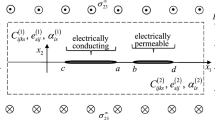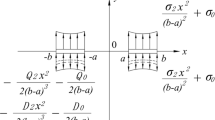Abstract
The solutions of a limited-permeable crack (case I) or two collinear limited-permeable cracks (case II) in piezoelectric/piezomagnetic materials subjected to a uniform tension loading were investigated in this paper using the generalized Almansi’s theorem. At the same time, the electric permittivity and the magnetic permeability of air in crack were firstly considered. Through the Fourier transform, the problem can be solved with the help of two pairs of dual integral equations, in which the unknown variables were jumps of displacements across crack surfaces, not the dislocation density functions or the complex variable functions. To solve the dual integral equations, the jumps of displacements across crack surfaces were directly expanded in a series of Jacobi polynomials to obtain the relations among electric displacement intensity factors, magnetic flux intensity factors and stress intensity factors at crack tips.
Similar content being viewed by others
References
Wu T.L., Huang J.H. (2000). Closed-form solutions for the magnetoelectric coupling coefficients in fibrous composites with piezoelectric and piezomagnetic phases. Int. J. Solids Struct. 37: 2981–3009
Wippler K., Ricoeur A., Kuna M. (2004). Towards the computation of electrically permeable cracks in piezoelectrics. Eng. Fracture Mech. 71: 2567–2587
Fujimoto Y., Shintaku E., Pirker G., Liu G. (2003). Piezoelectric sensor for stress intensity factor measurement of two dimensional cracks. Eng. Fracture Mech. 70: 1203–1218
Sih G.C., Song Z.F. (2003). Magnetic and electric poling effects associated with crack growth in BaTiO3 - CoFe2O4 composite. Theor. Appl. Fracture Mech. 39: 209–227
Song Z.F., Sih G.C. (2003). Crack initiation behavior in magnetoelectroelastic composite under in-plane deformation. Theor. Appl. Fracture Mech. 39: 189–207
Wang B.L., Mai Y.W. (2004). Fracture of piezoelectromagnetic materials. Mech. Res. Commun. 31(1): 65–73
Gao C.F., Kessler H., Balke H. (2003). Fracture analysis of electromagnetic thermoelastic solids. Eur. J. Mech. Solid 22(3): 433–442
Gao C.F., Tong P., Zhang T.Y. (2003). Interfacial crack problems in magneto-electroelastic solids. Int. J. Eng. Sci. 41(18): 2105–2121
Spyropoulos C.P., Sih G.C., Song Z.F. (2003). Magnetoelectroelastic composite with poling parallel to plane of line crack under out-of-plane deformation. Theor. Appl. Fracture Mech. 39(3): 281–289
Liu J.X., Liu X.L., Zhao Y.B. (2001). Green’s functions for anisotropic magnetoelectroelastic solids with an elliptical cavity or a crack. Int. J. Eng. Sci. 39(12): 1405–1418
Chung M.Y., Ting T.C.T. (1995). The Green function for a piezoelectric piezomagnetic anisotropic elastic medium with an elliptic hole or rigid inclusion. Philos. Mag. Lett. 72: 405–410
Pan E. (2002). Three-dimensional Green’s functions in anisotropic magneto-electro-elastic bimaterails. Zeitschrift fur Angewandte Mathematik und Physik 53: 815–838
Gao C.F., Kessler H., Balke H. (2003). Crack problems in magnetoelectroelastic solids. Part I: exact solution of a crack. Int. J. Eng. Sci. 41(9): 969–981
Gao C.F., Kessler H., Balke H. (2003). Crack problems in magnetoelectroelastic solids. Part II: general solution of collinear cracks. Int. J. Eng. Sci. 41(9): 983–994
Wang B.L., Mai Y.W. (2003). Crack tip field in piezoelectric/piezomagnetic media. Eur. J. Mech. Solid 22(4): 591–602
Chen W.Q., Lee K.Y., Ding H.J. (2004). General solution for transversely isotropic magneto-electro-thermo-elasticity and the potential theory method. Int. J. Eng. Sci. 42: 1361–1379
Wang X., Shen Y.P. (2002). The general solution of three-dimensional problems in magnetoelectroelastic media. Int. J. Eng. Sci. 40: 1069–1080
Van Suchtelen J. (1972). Product properties: a new application of composite materials. Phillips Research Reports 27: 28–37
Harshe G., Dougherty J.P., Newnham R.E. (1993). Theoretical modeling of 3-0/0-3 magnetoelectric composites. Int. J. Appl. Electromag. Mat. 4: 161–171
Avellaneda M., Harshe G. (1994). Magnetoelectric effect in piezoelectric/magnetostrictive multiplayer (2–2) composites. J. Intell. Mat. Syst. Struct. 5: 501–513
Nan C.W. (1994). Magnetoelectric effect in composites of piezoelectric and piezomagnetic phases. Phys. Rev. B 50: 6082–6088
Benveniste Y. (1995). Magnetoelectric effect in fibrous composites with piezoelectric and magnetostrictive phases. Phys. Rev. B 51: 16424–16427
Huang J.H., Kuo W.S. (1997). The analysis of piezoelectric/piezomagnetic composite materials containing ellipsoidal inclusions. J. Appl. Phys. 81(3): 1378–1386
Li J.Y. (2000). Magnetoelectroelastic multi-inclusion and inhomogeneity problems and their applications in composite materials. Int. J. Eng. Sci. 38: 1993–2011
Zhou Z.G., Wang B. (2004). Two parallel symmetry permeable cracks in functionally graded piezoelectric/piezomagnetic materials under anti-plane shear loading. Int. J. Solids Struct. 41: 4407–4422
Zhou Z.G., Wang B., Sun Y.G. (2004). Two collinear interface cracks in magneto-electro-elastic composites. Int. J. Eng. Sci. 42: 1157–1167
Zhou Z.G., Wu L.Z., Wang B. (2005). The dynamic behavior of two collinear interface cracks in magneto-electro-elastic composites. Eur. J. Mech. Solids 24(2): 253–262
Zhou Z.G., Wu L.Z., Wang B. (2005). The behavior of a crack in functionally graded piezoelectric/piezomagnetic materials under anti-plane shear loading. Archive Appl. Mech. 74(8): 526–535
Morse P.M., Feshbach H.: Methods of theoretical physics. vol.1, McGraw-Hill, New York (1958)
Gao H.J., Zhang T.Y., Tong P. (1997). Local and global energy release rates for an electrically yielded crack in a piezoelectric ceramics. J. Mech. Phys. Solids 45(4): 491–510
Hao T.H., Shen Z.Y. (1994). A new electric boundary condition of electric fracture mechanics and its applications. Eng. Fracture Mech. 47(6): 793–802
Govorukha V.B. (2006). On the influence of the electric permeability on an interface crack in a piezoelectric biomaterial compound. Int. J. Solids Struct. 43: 1979–1990
Suo Z., Kuo C.M., Barnett D.M. (1992). Willis J R Fracture mechanics for piezoelectric ceramics. J. Mech. Phys. Solids 40(4): 739–765
Zhang T.Y., Tong P. (1996). Fracture mechanics for a mode III crack in a piezoelectric material. Int. J. Solids Struct. 33: 343–359
Ueda S. (2006). Transient response of a center crack in a functionally graded piezoelectric strip under electromechanical impact. Eng. Fracture Mech. 73: 1455–1471
Zhong Z., Meguid S.A. (1997). Analysis of a circular arc-crack in piezoelectric materials. Int. J. Fracture 84: 143–158
McMeeking R.M. (1989). On mechanical stress at cracks in dielectrics with application to dielectric breakdown. J. Appl. Phys. 62: 3316–3122
Parton V.S. (1976) Fracture mechanics of piezoelectric materials, ACTA Astronautra 3, 671–683
Mikhailov G.K., Parton V.S.: Electromagnetoelasticity. Hemisphere, New York (1990)
Pak Y.E. (1990). Crack extension force in a piezoelectric material. J. Appl. Mech. 57: 647–653
Deeg W.E.F.: The analysis of dislocation, crack and inclusion problems in piezoelectric solids, Ph.D. thesis. Stanford University (1980)
Soh A.K., Fang D.N., Lee K.L. (2000). Analysis of a bi-piezoelectric ceramic layer with an interfacial crack subjected to anti-plane shear and in-plane electric loading. Eur. J. Mech. Solid 19: 961–977
Hao T.H. (2001). Multiple collinear cracks in a piezoelectric material. Int. J. Solids Struct. 38(50–51): 9201–9208
Yang F.Q. (2001). Fracture mechanics for a Mode I crack in piezoelectric materials. Int. J. Solids Struct. 38: 3813–3830
Ding H.J., Chen B., Liang J. (1996). General solutions for coupled equations for piezoelectric media. Int. J. Solids Struct. 33(16): 2283–2296
Gradshteyn I.S. (1980). Ryzhik IM. Table of integral, series and products. Academic
Erdelyi A. (1954). Tables of integral transforms, vol. 1. McGraw-Hill, New York
Author information
Authors and Affiliations
Corresponding author
Rights and permissions
About this article
Cite this article
Zhou, ZG., Zhang, PW. & Wu, LZ. Solutions to a limited-permeable crack or two limited-permeable collinear cracks in piezoelectric/piezomagnetic materials. Arch Appl Mech 77, 861–882 (2007). https://doi.org/10.1007/s00419-007-0135-z
Received:
Accepted:
Published:
Issue Date:
DOI: https://doi.org/10.1007/s00419-007-0135-z




